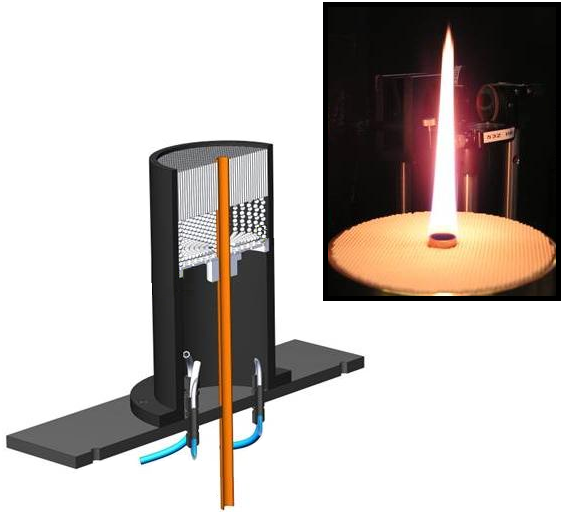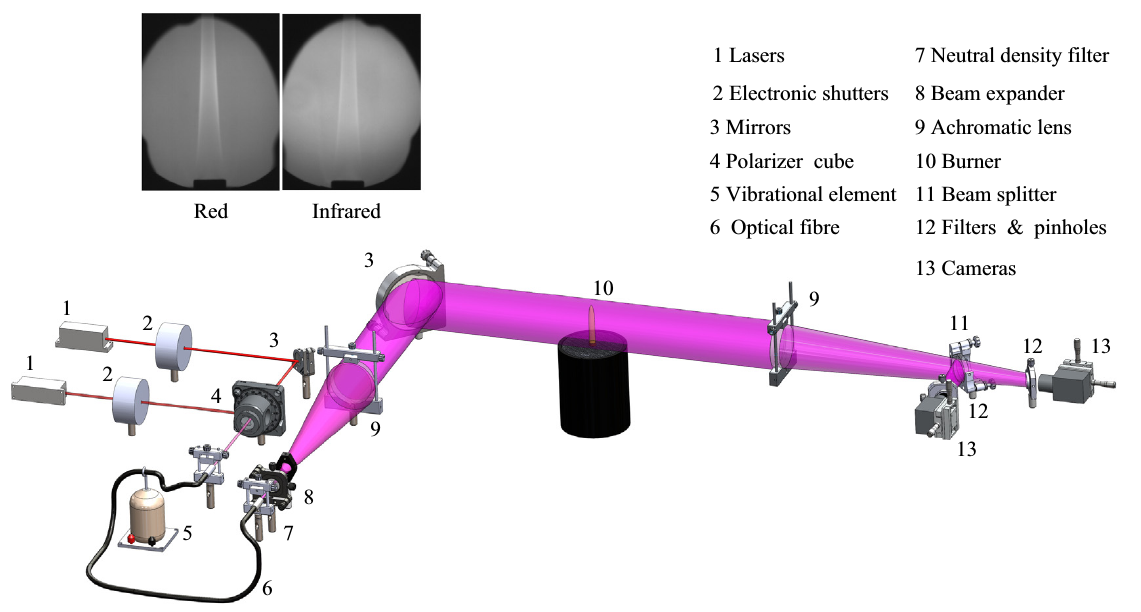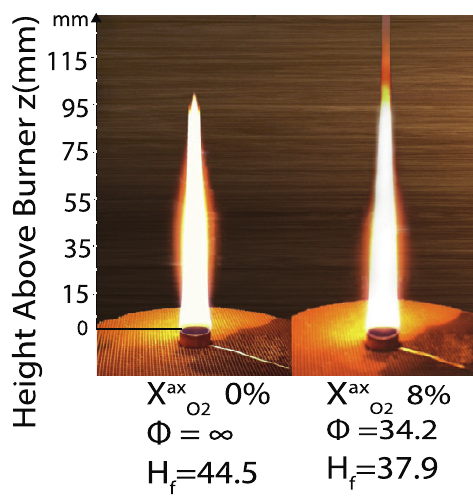Part of my research activities is dedicated to the understanding and control of the physico-chemical processes responsible for the emission of soot particles. I am involved in the research activities of the CEPT team aiming to develop optical diagnostics to probe the particles produced within flames. An original diagnostic technique called Modulated Absorption/Emission (MAE), developed in the laboratory, provides access to the temperature and volume fraction of soot particles in the flame. This new technique has been used to investigate stabilized flames on the Santoro burner (axisymmetric non-premixed laminar flames). Access to this information helps to better understand the mechanisms governing the production and consumption of soot particles.
Experimental setup
Burner
The burner used in this study is a co-axial jet burner allowing the stabilization of non-premixed flames (figure 1). This burner has identical features to the device set up by Santoro et al. (1983) *, considered as a reference burner for the investigation of soot formation in the combustion scientific community. In this device, the fuel is emitted at the center and the oxidant at the periphery. A combination of a glass bead bed and a ceramic honeycomb structure allows the oxidant flow to be laminar. In this way, the characteristics of the stabilized flames are rigorously defined and reproducible.

Laser diagnostic
The setup used to conduct the soot volume fraction measurements by absorption is shown in Figure 2. It allows access to the soot volume fraction concentration and temperature fields. To do this, the spontaneous emission of the flame is captured at two wavelengths (645 nm and 785 nm) using two cameras (number 13 on the picture). In parallel, the absorption at these wavelengths is measured using two laser beams whose intensity is captured by the same cameras with and without flame. In this approach, the absorption measurement gives access to the volume fraction of the soot particles, and the analysis of the spontaneous emission, corrected for self-absorption phenomena, gives access to the temperature of the particles. The details of this so-called modulated absorption/emission technique are presented in the publication by Legros et al. (2015) **.

Illustration: Legros et al. (2015) **
Results examples
The results presented in Figure 3 and taken from the work published in the paper by Wang et al. [6] illustrate the flame transition \og closed\fg (see Fig. 3 b) left-hand image) / opened flame (cf. fig. 3 b) right-hand image) of non-premixed and partially premixed flames of ethylene. The axial flow is composed of ethylene mixed with oxygen in increasing concentrations (0% to 32%). The peripheral flow is composed of air. This type of measurement allows a better understanding of the mechanisms leading to the opening of the flames, i.e. the significant release of particles at the top of these flames. In the present case, PAH formation pathways in the presence of oxygen are favored when oxygen is added to the fuel at levels up to 30\%. This results in accelerated inception of the first particles. Downstream in the flame, in the soot growth and oxidation zones, the oxidation mechanisms are then limited by the temperature decrease. All these contributions lead to the exhaust of particles at the top of the flame, clearly visible in figure 3 (b). The promoting effect of the addition of oxygen is suddenly reversed for oxygen concentrations above 30%. Beyond that point, the oxidation mechanisms become predominant.

(a) Soot volume fraction and temperature measurement in oxygen-doped ethylene flames
|
(b) Transition of ethylene flames without/with oxygen in axial flow |
* R. J. Santoro, H. G. Semerjian, and R. A. Dobbins. Soot particle measurements in diffusion flames. Combustion and Flame, 51:203–218, 1983.
** G. Legros, Q. Wang, J. Bonnety, M. Kashif, C. Morin, J.-L. Consalvi, and F. Liu. Simultaneous soot temperature and volume fraction measurements in axis-symmetric flames by a two-dimensional modulated absorption/emission technique. Combustion and Flame, 162(6):2705–2719, 2015.
Related publications
[1] R. Jalain et al., “Influence of sub-atmospheric pressure on flame shape and sooting propensity in ethylene laminar coflow non-premixed flame,” Combustion and Flame, vol. 259, p. 113173, 2024.
[2] R. Jalain, J. Bonnety, G. Legros, and A. Matynia, “Sooting tendencies of ethylene diffusion flame doped by C3 -C5 alcohols,” Proceedings of the Combustion Institute, vol. 39, no. 1, pp. 979–987, 2023.
[3] C. N. Maesano et al., “Impacts on human mortality due to reductions in PM10 concentrations through different traffic scenarios in Paris, France,” Science of The Total Environment, vol. 698, p. 134257, 2020.
[4] J. Bonnety et al., “Probing the local radiative quenching during the transition from a non-smoking to a smoking laminar coflow ethylene/air non-premixed flame,” Combustion and Flame, vol. 203, pp. 120–129, 2019.
[5] J. Abboud, J. Schobing, G. Legros, A. Matynia, J. Bonnety, V. Tschamber, A. Brillard, G. Leyssens, and P. Da Costa. Impacts of ester’s carbon chain length and concentration on sooting propensities and soot oxidative reactivity: Application to Diesel and Biodiesel surrogates. Fuel, 222:586–598, 2018.
[6] Q. Wang, G. Legros, J. Bonnety, C. Morin, A. Matynia, J.-L. Consalvi, and F. Liu. Experimental assessment of the sudden-reversal of the oxygen dilution effect on soot production in coflow ethylene flames. Combustion and Flame, 183:242–252, 2017.
[7] M. Kashif, J. Bonnety, A. Matynia, P. Da Costa, and G. Legros. Sooting propensities of some gasoline surrogate fuels: Combined effects of fuel blending and air vitiation. Combustion and Flame, 162(5):1840–1847, 2015.
